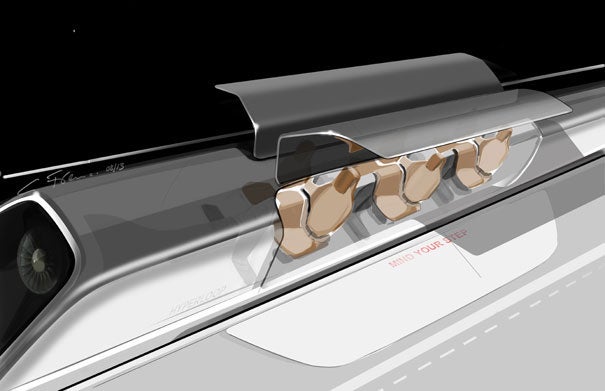This Is Elon Musk’s Hyperloop
Billionaire Elon Musk has announced details of Hyperloop, his mysterious high-speed transportation project. There was some of what we expected, and a few surprises, too.

SpaceX/Tesla Motors founder Elon Musk has unveiled details on the Hyperloop, his proposed (and until now mostly mysterious) plan for a railway system that could shoot passengers from Los Angeles to San Francisco in a mere 30 minutes.
It’s actually surprisingly close to what some early predictions forecasted: an elevated, low-friction, high-speed track based on pods, which would ferry people, and even cars, long distances at more than 700 miles per hour.
There are at least a few differences, though. The system was expected to run on a Maglev system (similar to that used in bullet trains) but it actually works through air bearings, a system that’s similar to the low-friction environment created on a hockey table. (On a conference call, Musk described it as falling somewhere between a completely sealed vacuum and a gigantic version of one of those pneumatic-tube systems mail was sent through in the ol’ days.) Musk told Bloomberg BusinessWeek:
The pods will ride on air bearings. The pod produces air, and it’s pumped out of little holes on these skis. This is something that is used quite a bit in industry. You can move huge, heavy objects with very low friction, using air bearings. In the consumer sense, people would be familiar with air hockey tables, except in this case the air bearings are being generated by the pod itself, as opposed to the tube.
You don’t want the tube to be expensive. Because the tube is so long, you want the expensive stuff to be in the pod.

Hyperloop Pod Sketch
Here are more details:
- The system would work for places about 900 miles apart or less–any more and supersonic air travel, Musk argues, would be a cheaper solution.
- Musk specifically uses a L.A.-to-San Francisco route as the proposed system. The Hyperloop would more or less follow along the I-5.
- In Musk’s plan, the Hyperloop could carry 840 passengers per hour, with 70 pods leaving every 30 seconds
- “[F]or trip comfort and safety, it would be best to travel at high subsonic speeds for a 350 mile journey.” Uhh, yes, seems like “high subsonic” (700-plus mph) would be sufficient.
- Hard to say what construction would be like for this. Presumably, Musk would have to fork over a lot of money to secure building rights along the I-5, which is dominated by farmland. Musk told BusinessWeek that, because the rail system would be elevated, there would be fewer land-rights issues. But that’s not going to solve everything, and could considerably increase the price tag.
- About every 70 miles, an electric motor would provide a boost to the individual pods, shooting them farther along the track. The same system could slow down the pods as they approach their destination, and the energy taken from that could be rerouted to power the next batch of pods.
- Musk said on the call that it “would feel a lot like being on an airplane”–“like riding on a cushion of air.” How? It doesn’t accelerate normally, but by banking along the tube, which would mean about a half-g of force.
- As for risk of crashing, Musk said on the call that shock-absorbing pylons could absorb any earthquakes that could be reasonably anticipated.
- This is still expensive. Six billion dollars for a system that could carry people and $10 billion for one that could carry cars. (Context: Musk points out that price tag is more than his companies Tesla Motors, SpaceX, and SolarCity spend combined, but a lot less than the proposed California High Speed Rail, which would theoretically be much slower.)
- Who’s going to make this thing, then? Well, Musk has said previously that he would release the plans as an open-source system, and let anyone have at them. On the conference call, he backed away from that slightly, saying he would be likely to build a prototype if no one else steps up. (That’s a surprise; he came off pretty firmly against the idea of building this thing himself recently.)
- On how long it would take: Musk says if a prototype were his top priority, he could get it done in one or two years–but since it won’t be (the guy has got a few other companies to run), the prototype could be more like three or four years. Musk estimates it will take seven to 10 years to make the full project a reality. Might be a little early (literally, it’s been, like, an hour since the plans were released) to be making estimates that far in the future.